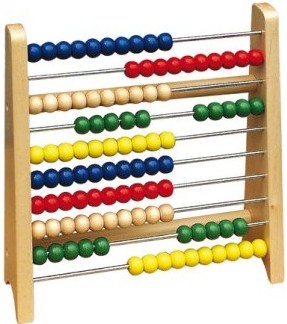Of primitive tribes is often assumed that they count as ‘1, 2,' (sometimes also) three and then 'lots'. Other tribes use(d), the fingers of one hand in order to count up to 5 or 10. And sometimes the toes were added there to 20. The Maya had a 20 -count system.
Prehistoric dots and stripes can be counts or records of numbers.
 By counting we appoint numbers. By tally (draw lines) we can track numbers.
By counting we appoint numbers. By tally (draw lines) we can track numbers.
For each number of a system, there is a symbol.
In the 12th century, King Henry I (England) let collect tax money and left a note by wide and narrow notching in a square (hazel) stick. Which was then split in two, so that each party had an identical and same copy: the tally stick.
Computers operate in a binary system with only two symbols or positions (of a circuit): 0 and 1.
The 12 - count system is reflected in the number of months and zodiac signs, the hours per day, and the dozen, which is convenient divisible by 2, 3, 4 and 6.
The sexagesimal numbering system we find in seconds and minutes, and corner partitions.
Both systems are somewhat obsolete.
Our course commonly used decimal system with Arabic numerals has 10 characters, starting with the important 0, without which there would be no system. It is a position system. A figure (such as a letter) is a symbol for an amount. A number represents an amount, displayed with (a combination of) figures (such as a word).
The place in a number determines the value of the digit: 14 counts 1 ten and 4 units; 41 has the same numbers in a different position: it gives 4 tens plus one unit displayed. Our symbols were taken over by the Arabs of the Indians.
Only around the year 400 did the indispensable figure zero entry. However, because the Romans used a completely different system, it still took a while before we could use it too. Especially the church, which wanted to keep the rich and powerful to friend with knowledge of Roman numerals, prohibited the use of diabolical Arabic numerals! They were only abolished by the French Revolution in 1791.
If you do not have a zero and you want to display 603 as 6 3, then will come some problems for sure. Hence, the use of the zero, and its position between -1 and 1, is a great invention.
An empty place for zero in the decimal system was used in China as early as the 4th century BC. For them, apparently it was sufficient.
Around the 2nd century BC, they were already using negative numbers. Long before India, and much earlier than the West.
Then it becomes easier in an orderly and logical way to add abstract numbers together, to reduce, to shrink...
That is called arithmetic. It requires understanding and practice.
Four out of three people have trouble with math.
But it has many advantages if you can manage it.
How many poles do I need to fence a meadow?
How many seed items do I need to plant a field of aa X bb meters?
If we every week need 6 kg of potatoes, how much stock do I have to build in order to bridge the winter and spring for 6 months?
So it gives you a certain power to define problems to assess and manage them.
Parts of a unit can be indicated decimal (with a comma: 0,25 and in Anglo-Saxon countries with point 1.5) or by a fraction that gives the number of parts (e.g. here ¼ or 3/2.).
In a fraction the upper figure is called the numarator, which shows how much parts we count.
The bottom number is the denominator, which appoints how many parts are in a unity.
If you cut a cake into 8 parts (1 = 8/8) and eat two pieces, then 2/8th is gone and there remains 6/8th.
You can fractals add or subtract only if they have the same denominator.
To calculate with numbers we have different operations: addition - subtraction - multiplication - division - square – square roots.
The order in which operations are performed is indicated by brackets. Operations within parentheses are performed first. If several consecutive operations is the necessary order (to remember using a mnemonic): PEMDAS stands for Parentheses, Exponents, Multiplication, Division, Addition, Subtraction. PEMDAS is often expanded to "Please Excuse My Dear Aunt Sally".
The tricks to write numbers below each other and then apply operations is one of the basic skills that are taught us worldwide through school education.
Difference number- numeral - digit
A digit is a single symbol used to make numerals.
A numeral is a symbol or name that stands for a number.
A number is a count or measurement, an idea in our minds.
The abacus has on each rod 10 beads. There is a bar for units, tens, hundreds, etc. So even big numbers can easily be added and subtracted.
Around 1620 made Edmund Gunter and William Oughtred a slide rule with two sliding parallel logarithmic scales. To multiply two numbers are added together and their logarithm was raised to the tenth power. Multiplication and division thus became as simple as addition and subtraction.
There are three kinds of people. People who can count and those who cannot count..
